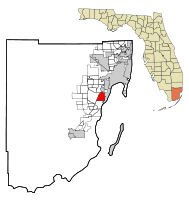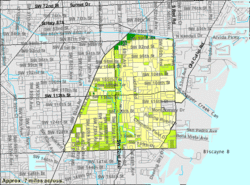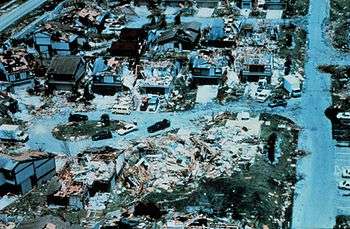Pinecrest, Florida
| Pinecrest, Florida | ||
|---|---|---|
| Village | ||
| Village of Pinecrest | ||
| ||
 Location in Miami-Dade County and the state of Florida | ||
 U.S. Census Bureau map showing village boundaries | ||
| Coordinates: 25°40′N 80°18′W / 25.667°N 80.300°WCoordinates: 25°40′N 80°18′W / 25.667°N 80.300°W | ||
| Country |
| |
| State |
| |
| County |
| |
| Incorporated | March 12, 1996 | |
| Government | ||
| • Type | Council-Manager | |
| • Mayor | Joseph Corradino | |
| • Vice Mayor | Doug Kraft | |
| • Councilmembers | Cheri Ball, Anna Hochkammer, James McDonald | |
| • Village Manager | Yocelyn Galiano Gomez | |
| • Village Clerk | Guido H. Inguanzo, Jr. | |
| Area | ||
| • Village | 7.6 sq mi (19.6 km2) | |
| • Land | 7.5 sq mi (19.5 km2) | |
| • Water | 0.1 sq mi (0.1 km2) 0.13% | |
| Elevation | 3 ft (1 m) | |
| Population (2010) | ||
| • Village | 18,223 | |
| • Density | 2,448.9/sq mi (945.5/km2) | |
| • Metro | 5,422,200 | |
| Time zone | EST (UTC-5) | |
| • Summer (DST) | EDT (UTC-4) | |
| Zip Codes | 33156 | |
| Area code(s) | 305, 786 | |
| FIPS code | 12-56625[1] | |
| GNIS feature ID | 1764896[2] | |
| Website | http://pinecrest-fl.gov | |
Pinecrest is a suburban village in Miami-Dade County, Florida, United States of America. The population was 18,223 as of the census[1] of 2010. Pinecrest is governed by a five-member Village Council[3] and operates under the Council-Manager form of government.[4] 33156, the zip code that encompasses all of the village, has been consistently ranked as one of the most expensive in the United States.[5]
Media
The Village of Pinecrest has its own newspaper, "The Pinecrest Tribune, which is published bi-weekly and is part of Miami Community Newspapers. The Village of Pinecrest is also served by the Miami market for local radio and television.
Geography
Pinecrest is located at 25°40′N 80°18′W / 25.667°N 80.300°W (25.6619, −80.3076).[6]
According to the United States Census Bureau, the village has a total area of 7.6 square miles (20 km2). 7.5 square miles (19 km2) of it is land and 0.13% is water.
Community projects
Pinecrest's projects since 1996 include the addition of several new parks, development of Wi-Fi technology and beautification projects which included thousands of trees being planted, unique street signs being posted Village-wide, and roads being repaved. By planting over 10,000 street trees since 1997, Pinecrest was named a Tree City USA community by the Arbor Day Foundation.
In 2008, the Village Council dedicated the new Flagler Grove Park and the long-awaited Community Center at Pinecrest Gardens. The Pinecrest branch of the Miami-Dade County Library System opened adjacent to the Community Center in October 2008.
Pinecrest Gardens
Pinecrest Gardens is the crown jewel of the village's park system. Known as South Florida's Cultural Arts Park, it is a massive park featuring over 1,000 varieties of exotic tropical plants and trees. The park offers beautiful landscape featuring natural streams, sinkholes, caves and fissures. The park also offers various programs including summer camps. The park is located on the former site of the Parrot Jungle.[7]
History
During the 1900s, Miami pioneer and railroad tycoon Henry Flagler used the property at U.S. 1 and Southwest 102 Street as a staging area during the construction of the Overseas Railroad to the Florida Keys.
In the 1930s, the area’s growth continued and the community began to evolve around one of the first tourist attractions established in the Miami vicinity – Parrot Jungle and Gardens. Parrot Jungle was founded in 1936 by Franz and Louise Scherr on property located at Red Road and Southwest 111 Street and over the years became a world-famous tourist attraction whose visitors included Sir Winston Churchill. The idea for Parrot Jungle began after Scherr, who owned and operated a feed and supply store in Homestead, Florida, became intrigued with the idea of building an attraction where birds would “fly free.” To bring his vision to life, he rented 20 acres (81,000 m2) of hammock land for an annual fee of $25. Parrot Jungle was built as a winding nature trail dug through the coral rock and hammock land, indigenous to the area. All the natural plants were left undisturbed. The entrance was built on Red Road. The attraction opened on December 20, 1936, to about 100 visitors. Each paid 25 cents admission to see and hear Scherr talk about his birds, trees and flowers. Since 1936, Parrot Jungle has attracted over a million visitors and became a world-famous tourist attraction. On December 17, 2002, the Village of Pinecrest purchased the Parrot Jungle with the aim of developing the site as Pinecrest Gardens. On March 8, 2003 the Pinecrest Village Council dedicated Pinecrest Gardens and officially opened it to the public as the Village’s newest municipal park. The attraction moved to a new waterfront location on Watson Island between Downtown Miami and Miami Beach. It was relaunched as Parrot Jungle Island.
The Miami Serpentarium, another popular tourist attraction which featured serpents (snakes) lizards and other reptiles and amphibians, was located on US 1 for many decades prior to closing in the mid-1980s.
During the 1950s and 1960s the area flourished with the development and construction of ranch-style houses on 1 acre (4,000 m²) lots which laid the foundation for the community’s rural and lushly landscaped residential character.

In August 1992, Pinecrest and the surrounding South Miami-Dade area were severely devastated by the effects of Hurricane Andrew. Many of the homes and businesses in the area were destroyed. In the subsequent years, the area was slowly rebuilt.[8][9]
Rapid growth and local issues during the 1990s inspired a movement led by residents Evelyn Greer Langlieb and Gary C. Matzner to incorporate the area.
The Village of Pinecrest was officially incorporated on March 12, 1996. Greer was elected the first mayor and was succeeded, after serving two terms, by Matzner in 2004. The founding Village Council, including Greer, Cindie Blanck, Barry Blaxberg, Leslie Bowe, Robert Hingston, together with Village Manager Peter G. Lombardi and Village Clerk Guido Inguanzo, are credited with establishing well-regarded municipal services including police, parks and recreation, building and planning services, and public works.[10]
Parks
There are five public parks in Pinecrest that the Parks and Recreation Department is responsible for:
- Coral Pine Park
- A 9-acre park with a recreation center, six lighted tennis courts, a natural area, an all-purpose field and a tot lot. Coral Pine Park was a former Miami-Dade County park before being transferred to Pinecrest in 1998.
- Flagler Grove Park
- A 3-acre facility with lighted youth soccer fields, a playground, parking and restrooms. As mentioned above, the park was dedicated in 2008.
- Evelyn Greer Park
- A 10-acre park with multipurpose athletic fields, batting cages, a tot lot, and a recreation center and community gazebo with a Wi-Fi spot. Formerly known as Pinecrest Park, it was re-designated on November 9, 2004 in recognition of Pinecrest's first mayor.
- Suniland Park
- A 10-acre park with baseball and football fields, batting cages, a recreation center, basketball courts, a tot lot and a gazebo with a Wi-Fi spot.
- Veterans Wayside Park
- A 4.5-acre park with a freshwater lake and open recreation areas.
Transportation
Pinecrest is served by Metrobus throughout the area and by Miami Metrorail at the following stations:
- Dadeland North (SW 70th Avenue and U.S. 1)
- Dadeland South (Dadeland Boulevard and U.S. 1)
Demographics
| Historical population | |||
|---|---|---|---|
| Census | Pop. | %± | |
| 2000 | 19,055 | — | |
| 2010 | 18,223 | −4.4% | |
| Est. 2015 | 19,452 | [11] | 6.7% |
| Pinecrest Demographics | |||
|---|---|---|---|
| 2010 Census | Pinecrest | Miami-Dade County | Florida |
| Total population | 18,223 | 2,496,435 | 18,801,310 |
| Population, percent change, 2000 to 2010 | −4.4% | +10.8% | +17.6% |
| Population density | 2,448.9/sq mi | 1,315.5/sq mi | 350.6/sq mi |
| White or Caucasian (including White Hispanic) | 90.1% | 73.8% | 75.0% |
| (Non-Hispanic White or Caucasian) | 50.4% | 15.4% | 57.9% |
| Black or African-American | 2.0% | 18.9% | 16.0% |
| Hispanic or Latino (of any race) | 41.3% | 65.0% | 22.5% |
| Asian | 5.3% | 1.5% | 2.4% |
| Native American or Native Alaskan | 0.1% | 0.2% | 0.4% |
| Pacific Islander or Native Hawaiian | 0.0% | 0.0% | 0.1% |
| Two or more races (Multiracial) | 1.6% | 2.4% | 2.5% |
| Some Other Race | 0.9% | 3.2% | 3.6% |
As of 2010, there were 6,619 households out of which 6.4% were vacant. In 2000, 47.6% had children under the age of 18 living with them, 70% were married couples living together, 8.7% had a female householder with no husband present, and 19% were non-families. 15.1% of all households were made up of individuals and 4.9% had someone living alone who was 65 years of age or older. The average household size was 3.04 and the average family size was 3.39.
In 2000, the village population was spread out with 31.4% under the age of 18, 5.6% from 18 to 24, 27.2% from 25 to 44, 25.5% from 45 to 64, and 10.2% who were 65 years of age or older. The median age was 38 years. For every 100 females there were 93.3 males. For every 100 females age 18 and over, there were 89.4 males.
In 2000, the median income for a household in the village was $105,557, and the median income for a family was $122,526. Males had a median income of $88,091 versus $35,806 for females. The per capita income for the village was $56,723. About 2.4% of families and 4.2% of the population were below the poverty line, including 3.3% of those under age 18 and 3.5% of those age 65 or over.
As of 2000, speakers of English as a first language accounted for 58.09%, while Spanish made up 35.08%, French and Portuguese were tied at 1.91%, Chinese speakers were at 1.67%, Arabic at 0.89%, and German as a mother tongue consisted of 0.46% of the population.[13]
As of 2000, Pinecrest had the thirty-fourth highest percentage of Cuban residents in the US, with 13.71% of the populace (tied with Tavernier, Florida.)[14] It had the ninety-second highest percentage of Colombian residents in the US, at 1.78% of the village's population (tied with Cooper City and the borough of South Bound Brook, New Jersey,)[15] and the thirty-fifth highest percentage of Nicaraguan residents in the US, at 1.20% of its population.[16]
Education
Pinecrest is served by the Miami-Dade County Public Schools system.
Public Elementary Schools
- Howard Drive Elementary School
- Pinecrest Elementary School
- Palmetto Elementary School
Public Middle Schools
- Palmetto Middle School
Public High Schools
Private Schools:
- Bet Shira Congregation
- Gulliver Preparatory
- Kendall United Methodist
- Pinecrest Presbyterian
- St. Louis Covenant School
- Temple Beth Am
References
- 1 2 "American FactFinder". United States Census Bureau. Retrieved 2008-01-31.
- ↑ "US Board on Geographic Names". United States Geological Survey. 2007-10-25. Retrieved 2008-01-31.
- ↑ "Village of Pinecrest". © 2011 Village of Pinecrest. All Rights Reserved=2011-05-26.
- ↑ "Village of Pinecrest". © 2011 Village of Pinecrest. All Rights Reserved=2011-05-26.
- ↑ "America's Most Expensive ZIP Codes - Forbes". Forbes. Retrieved 2015-11-12.
- ↑ "US Gazetteer files: 2010, 2000, and 1990". United States Census Bureau. 2011-02-12. Retrieved 2011-04-23.
- ↑ Welcome to Pinecrest Gardens
- ↑ http://www.miamiherald.com/2012/08/17/2956273/photo-gallery-08-17-141113.html
- ↑ http://www.miamiherald.com/2012/08/18/2958131/the-fury-of-andrew.html
- ↑ The History of Pinecrest, Florida
- ↑ "Annual Estimates of the Resident Population for Incorporated Places: April 1, 2010 to July 1, 2015". Retrieved July 2, 2016.
- ↑ "Census of Population and Housing". Census.gov. Archived from the original on May 11, 2015. Retrieved June 4, 2015.
- ↑ "MLA Data Center Results of Pinecrest, Florida". Modern Language Association. Retrieved 2015-01-11.
- ↑ "Ancestry Map of Cuban Communities". Epodunk.com. Retrieved November 2, 2007.
- ↑ "Ancestry Map of Colombian Communities". Epodunk.com. Retrieved November 2, 2007.
- ↑ "Ancestry Map of Nicaraguan Communities". Epodunk.com. Retrieved November 2, 2007.
- ↑ "Boundaries." Miami Palmetto High School. Accessed October 30, 2008.
External links
| Wikimedia Commons has media related to Pinecrest, Florida. |
- Village of Pinecrest official website


